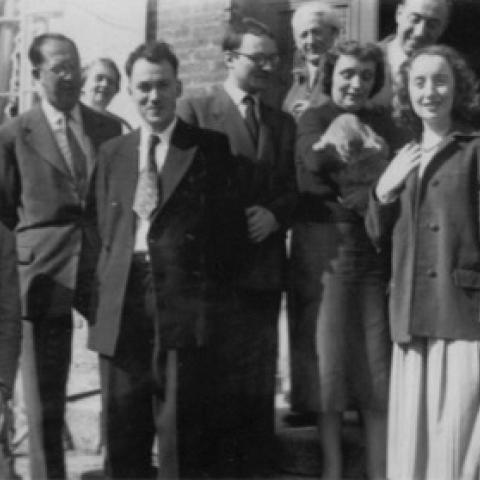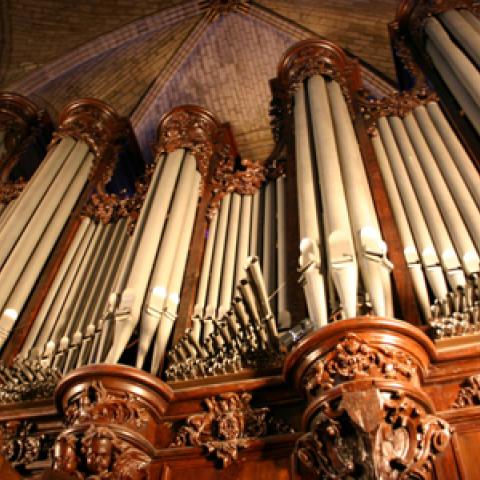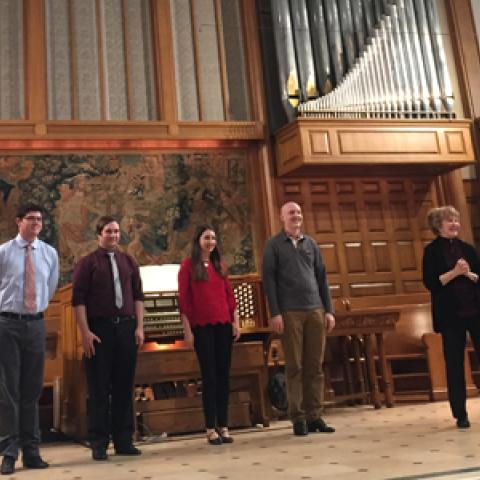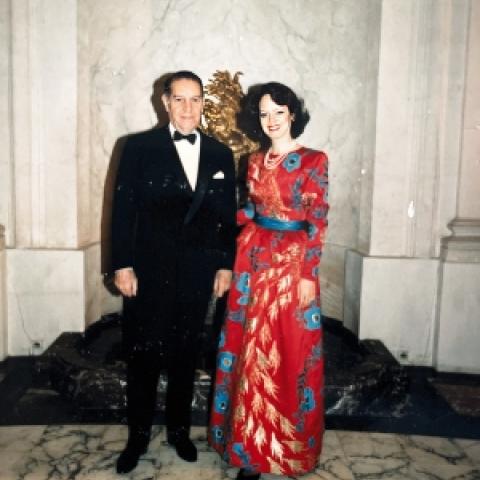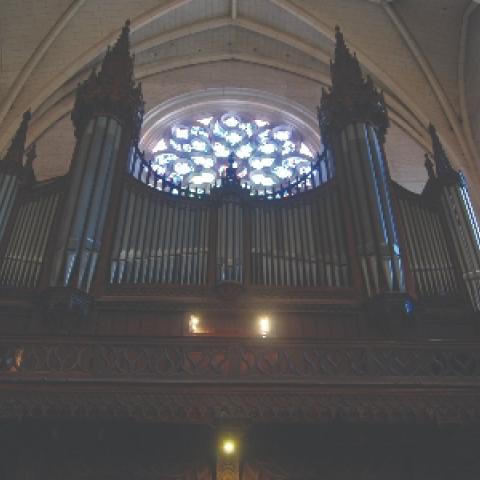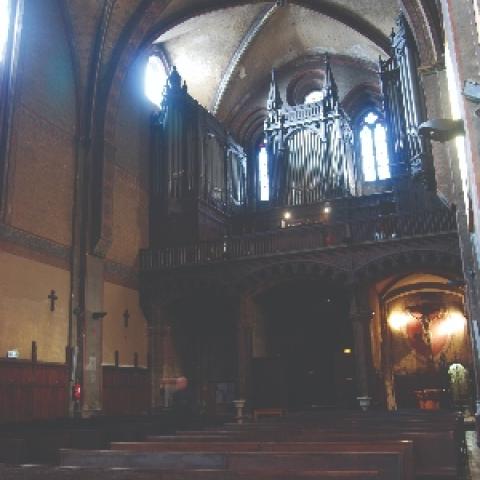Submitted by Masako Gaskin, BFOMS co-director, and David Erwin, director of music at Ladue Chapel Presbyterian Church, St. Louis, Missouri.
The British and French Organ Music Seminar (FOMS) took place in London, Paris, and Alsace, July 4–18, 2019. Founded by Christina Harmon in 1986, FOMS has taken place biennially since.
London
Thirty-seven organists and friends began the seminar with a Fourth of July celebration at Saint Paul’s Cathedral, London. The group was treated to Evensong and a concert by Ken Cowan on the Henry Willis organ (1872), originally built by Bernard Smith (1697). Afterwards, our host Simon Johnson demonstrated the instrument and invited participants to play.
The following morning the group traveled to All Saints Church, Tooting, to visit the 1904 Harrison & Harrison organ, hosted by Mark Pybus. Then on to Notre Dame de France for a masterclass in improvisation with Duncan Middleton on the organ tonally reconstructed and enlarged by B. C. Shepherd & Son of Edgware (1986). The afternoon was spent at St. George’s Hanover Square, hosted by Simon Williams. The organ, built by Richards, Fowkes & Co. (2012) inside the old case used for the first organ of 1725 by Gerald Smith, nephew of the builder of Saint Paul’s Cathedral organ, is the first American-built organ in London. That evening some members of the group attended vespers at Westminster Cathedral before the demonstration of its Henry Willis III organ (1922) and free playing time hosted by Peter Stevens.
Saturday, July 5, started at Chelmsford Cathedral, with James Davy as host for the group as they visited the Mander organs (nave and chancel). The second stop was at Saint Edmundsbury Cathedral hosted by James Thomas, playing the Harrison & Harrison organ (2010). Next was Cambridge, with Evensong conducted by Stephen Cleobury, who performed his final organ recital.
The final day in England was Sunday, July 6, and group members went to worship at churches of their choice. In the afternoon, one could attend a recital at Westminster Abbey or Westminster Cathedral. The final playing session on a two-manual George Pike England organ took place at Saint Margaret Lothbury, a church designed by Christopher Wren, with host organist Richard Townend.
Paris
On Tuesday, July 8, forty-four organists and friends converged in Paris at St-Augustin. Titulaire Didier Matry demonstrated the organ and allowed participants to try it out. The first full day of the seminar began with an emphasis on French classical music with visits to St-Sevérin and St-Gervais. François Espinasse led a masterclass at St-Sevérin, and he talked about the importance of singing and dancing in one’s playing. At St-Gervais, the Couperin family church, Elise Friot demonstrated one of the ancient instruments in Paris, with reportedly the oldest keyboards still in use in the city. That evening featured a concert by the Duo Merlin at Notre-Dame-des-Champs, parish church of organbuilder Aristide Cavaillé-Coll. The Duo Merlin consists of Yannick Merlin and his wife Béatrice Piertot, who specialize in organ music for four hands. They did much of the work in organizing FOMS from the French side, securing venues and recruiting faculty.
On Wednesday, July 9, Susan Landale lectured and led a masterclass on the works of Louis Vierne at Église St-Louis des Invalides. Then, several in the group walked to Ste-Clotilde to hear and play the organ, hosted by Olivier Penin. The next day saw a return to Notre-Dame-des-Champs for playing time, followed by a masterclass on works of Jean Langlais by Béatrice Piertot. This was followed by a class led by Jean-Baptiste Robin. That evening we visited the auditorium at Radio France, with its 2016 Gerhard Grenzing organ (IV/87). We were welcomed by M. Grenzing, and then each person in the group was able to play from the main stage console.
A trip to Auvers-sur-Oise (the village where painter Vincent Van Gogh spent his final days) was scheduled for the next day. A short train ride from Paris, Auvers is home to Église Notre-Dame d’Auvers-sur-Oise, which Van Gogh immortalized in a painting. The church has a newer organ built in the neo-Baroque style by Bernard Hurvy, demonstrated by M. Hurvy and the titulaire Jean-Charles Gandrille. Playing time for the group followed, while some explored the village. In the evening we visited St-Étienne-du-Mont, Duruflé’s church known for its elegant ornate rood screen. Titulaire Vincent Warnier welcomed us.
On Saturday, July 13, we had an early morning visit to Sacré-Coeur, where we had permission to play the organ. Titulaire Gabriel Marghieri explained to the group how plans for work on the organ have been drawn, funding has been secured, yet approval is tied up in the French bureaucracy. So in the meantime M. Marghieri must deal with severe winding issues, which does not permit him to use the Récit division at all. That afternoon featured a masterclass on works of César Franck led by Béatrice Piertot at the Church of St-Laurent where she is titulaire. Mme. Piertot shared some of her recent research into Franck’s organ works, including observations about tempi. That evening finished with a session at St-Eustache, with co-titulaire Baptiste-Florian Marle-Ouvrard playing the Van den Heuvel (V/101) organ.
On Sunday morning, July 14, participants had the choice of visiting several organ lofts in order to watch the work of the titulaires up close. The group then met up that afternoon at La Trinité where titulaire Loïc Mallie demonstrated the organ of Guilmant, Messiaen, and Hakim, and then gave very helpful comments as group members played for him. Many in the group rushed back to St-Eustache to hear Baptiste-Florian give a Bastille Day recital prior to evening Mass. This day concluded at St-Sulpice. Following a pontifical Mass (St-Sulpice is currently being used for large episcopal services that would have normally taken place at the cathedral) with a brilliant sortie improvised by Sophie Choplin, the church was ours for the next few hours as the building was locked and nighttime fell.
The final day in Paris, Fréderic Blanc hosted us at La Madeleine, talking about the history of this early Cavaillé-Coll instrument and then demonstrating it. Group members spent the remainder of the morning trying out this organ. The group moved to the chic Champs-Elysées neighborhood for a visit to St Pierre-de-Chaillot, where titulaire Samuel Liégeon presented an improvisation. On the way back to the métro we stopped at the American Cathedral to meet organist Andrew Dewar. The next event was a visit to the Duruflé apartment, where host Fréderic Blanc demonstrated the organ and spoke of Maurice and Marie-Madeleine Duruflé. The final event was a session with Blanc at his church, Notre-Dame-d’Auteuil, where the organ was recently renovated.
Alsace
Tuesday, July 16, began with an express train from the Gare de l’Est to Strasbourg. Daniel Roth joined us and shared insights of the heritage of his native Alsace. The afternoon was spent visiting two churches in the old part of this city. St-Pierre-le-Jeune Protestant (the church has been Lutheran since 1524) is home to an instrument built in 1780 by Johann Andreas Silbermann. This was followed by a visit to St-Pierre-le-Jeune Catholic Church, a massive nineteenth-century domed edifice built in the neo-Romanesque style. The present organ in this church is the work of Manufacture d’orgues Koenig from Sarre-Union, which incorporates some pipework of the earlier organ. After dinner, the group met at the church of St-Paul that was originally built for members of the military, but since 1919 has been part of the Protestant Reformed Church of Alsace and Lorraine. The church contains a notable Walcker organ (III/87) from 1897 in the gallery (the largest instrument in Alsace) and an eighteen-rank instrument (1976) built by Garnier Facteurs d’Orgues of Niiza in the chancel.
The next day we traveled to the village of Erstein, where we were welcomed by the mayor and tried out the 1914 instrument by Edmond-Alexandre Roethinger. This organ is a synthesis of French and German styles, which is typical for Alsatian organs. The city then hosted a reception for us and some members were interviewed for the local newspaper, which ran a story about FOMS the following day. The day continued with a visit to the abbey at Ebersmunster, a magnificent building in the high-Baroque style with an organ by André Silbermann (1730).
The final day for FOMS 2019 began at the Protestant Church of St-Martin in Barr. This Lutheran church boasts a Stiehr-Mockers organ from 1852. We then headed up in the mountains above Pfaffenheim for a luncheon of traditional Alsatian foods at the religious community of Schauenberg. The afternoon consisted of a visit to our final church, St-Martin, with its 1839 Callinet Brothers organ. After the demonstration of the organ, some members of the group remained to prepare for the evening’s recital, while others enjoyed a visit to a family-run chocolatier and a tasting of local Alsatian wines. FOMS concluded with a recital played by several members.
The following day, a smaller group that had originally registered for an extension to play at Notre-Dame de Paris, sadly devastated by the tragic fire of April 15, was hosted by Notre-Dame titulaire Johann Vexo in his charming hometown of Nancy. Eighteen organists and friends enjoyed the Dupont organ (modified later by Cavaillé-Coll) at Cathédrale Notre-Dame de Nancy and the Dalstein & Haepfer organ at Église St-Sébastien.
In addition to Yannick Merlin, Béatrice Piertot, and Daniel Roth, Christina Harmon was assisted by co-directors David Erwin, Masako Gaskin, and Cliff Varnon. Plans are already underway for the next FOMS, which will take place in July 2021. Look for announcements at www.bfoms.com for updates.
Photo: Jean-Baptiste Robin with seminar participants at Notre Dame-des-Champs, Paris, France (photo credit: Masako Gaskin)

